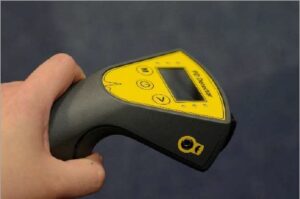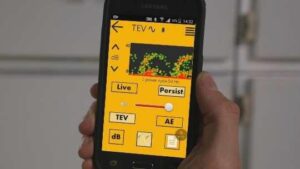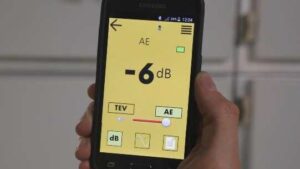Portable partial discharge detector
(PD Detector)



About PD Detector (Portable Partial Discharge Detector)
- Ultrasonic detection of partial discharge activity on the surface, the discharge value can be displayed on the screen or the sound signal can be heard through the earphone.
- Measure the TEV signal generated by partial discharge on the surface, and display the discharge value through the screen.
- The partial discharge phase analysis mode can observe the partial discharge spectrum in the power cycle and distinguish the noise.
- Measure the pulse signal generated by internal partial discharge and display the discharge value on the screen.
Partial discharge detection
Switchboard
– Air Insulated Switch
The partial discharge activity in the metal layer of the high-voltage plate will generate a tiny voltage pulse signal, which is called a transient earth voltage (TEV) signal. The TEV is transmitted on the surface of the metal plate, and the signal is transmitted to the switchgear) can be transmitted from the inside along the surface to the outer surface of the disk body, so the TEV signal can be detected by the PD Detector (portable partial discharge detector) outside the switch disk.
Defects on the surface of high-voltage insulating materials tend to be known as surface discharge tracking (Tracking) phenomenon. Such discharge tracks will cause carbonization and produce carbon deposits over time, which will eventually lead to flashover and insulation deterioration. PD Detector (portable local Discharge detector) can effectively detect the sound leakage phenomenon (ultrasonic signal, known as corona discharge (Corona)) generated by the discharge track, and prevent problems before they occur.
Switchboard
– Gas Insulated Switch
Ultra-high frequency sensor (UHF) can be used to detect whether there is a discharge signal at the high-voltage cable terminal (cable head), and is suitable for gas-insulated switchgear such as GIS, GIL, and GIT. ) generally captures the signal at a frequency of 200MHz~2GHz, and is fixed in the spacer of the gas-insulated switch (GIS), so as to distinguish where the signal comes from.
High voltage cable
Partial discharge in solid insulating materials will induce weak high-frequency currents in the grounding system or power system. Such pulse signals will pass along the grounding system from the inside of the high-voltage coil of the equipment to the grounding terminal. When the partial discharge signal passes through the high voltage When a high frequency current surge sensor (HFCT) is used, the sensor can capture and analyze the partial discharge (PD) signal at the ground terminal.
Advantage
- GIS, GIL, GIT and other gas-insulated switchgear are suitable – quick inspection! The effect is outstanding!
- Fully applicable to various high – voltage equipment inspections – can be used with various sensors of HFCT/CC-TEV/UHF/AA.
- Advanced noise elimination – the system detects PD in a high noise environment, reducing the chance of false positives.
- Partial Discharge Phase Analysis (PRPD) – PRPD technology can help users distinguish between noise and PD signals.
- Computer and cloud synchronization – you can use the built-in software to synchronize and store data to your computer, or remotely store data to a cloud database with various devices.
- Site-wide rapid inspection – detects medium and high voltage equipment problems before they develop into actual failure risks.
- Trends – Record PD data for each device and review high voltage devices that have never been tested before.
- Comprehensiveness and efficiency – Use comprehensive technology and sensors to quickly detect potential risks of high-voltage equipment.
- Install the App software on the mobile phone – it can be monitored remotely, and will not miss any potential risks of high-voltage equipment.
- Can be matched with a dish – shaped ultrasonic detector – can inspect outdoor switch yards, high-voltage electrical towers or indoor high-voltage equipment.
| Transient Earth Voltage (TEV) Testing | Operating Environment | |||
|---|---|---|---|---|
| Measurement range | 0 to 80dBmV | Operating temperature | 0°C to 60°C | |
| Measurement bandwidth | 3 to 200MHz (with FM Bandstop) | Humidity | 0 – 95% RH non-condensing | |
| Resolution | 1dB (Accuracy ±1dB) | Protection level | IP54 | |
| Noise exclusion | Yes, with PRPD | Technology Application | ||
| Ultrasonic Testing | Communication method | Bluetooth | ||
| Measurement range | -6dBµV to + 68dBµV | Data storage | Customer Server | |
| Resolution | 1 dB (Accuracy ±1 dB) | Data access | Web front end, SAP, Oracle, etc. | |
| Sensor sensitivity | -65dB (0dB = 1volt/µbar RMS SPL) | Mobile phone software | Android, iOS | |
| Sensor center frequency | 40 kHz | Report | Yes | |
| HFCT Sensor | Results Shown | PD Level, Noise Level, PRPD | ||
| Measurement range | 0 to 50,000pC | Dimension | ||
| Measurement bandwidth | 60kHz to 70MHz | Host dimension | 190 x 90 x 55 mm | |
| Resolution | 5pC (Accuracy ±5pC) | Host weight | 210 g | |
| UHF Sensor | Carton size | 295 x 340 x 145 mm | ||
| Measurement range | 0dB-75dB | Total weight | 2.9 kg | |
| Resolution | 1dB (Accuracy ±1dB) | Power | ||
| Measurement bandwidth | 200MHz – 2.0GHz | Built-in battery | Lithium Ion, 3.75V, 2.2Ah, 8.25Wh | |
| Hardware | Charging time (estimated) | 5 hours | ||
| Protection box | Injection moulded plastic case | Battery Charger | ||
| Control | Membrane keypad | Charging temperature | 0°C to 45°C | |
| External device | Power, Headphones and optional sensors | Rated voltage | 100 to 250 VAC, 5V, 3A | |
| Screen | OLED with level LEDs | Frequency | 47 to 63Hz | |
| Transformer plug (can be converted to domestic specifications) | UK, EU, Australia, USA | |||
| Charging time | 3 hours | |||
| Compliance with regulations | CE-compliant in accordance with EMC Directive (2014/30/EU) | |||
| Designed and manufactured in the UK | ||||


